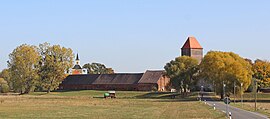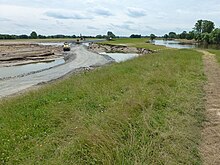Gruna (LauWEIS)
|
Gruna
community Laußig
Coordinates: 51 ° 31 ′ 42 " N , 12 ° 37 ′ 6" E
|
|
|---|---|
| Height : | 93 m |
| Area : | 1.01 km² |
| Residents : | 216 (2008) |
| Population density : | 213 inhabitants / km² |
| Incorporation : | 1st January 1974 |
| Postal code : | 04838 |
| Area code : | 034242 |
Gruna is a district of the municipality Laussig in the district of Nordsachsen in the German state of Saxony .
geography
Gruna is located about 9 kilometers north of Eilenburg and 10 kilometers south of Bad Düben at the end of a 1.5 km long spur road that branches off from State Road 11 to the west . The hollow flows directly past the place. A Gierseil passenger ferry leads across the river to Hohenprießnitz . The place borders on the Dübener Heide nature park .
history
For a long time it was assumed that Gruna was the old Wendish city of Gana , which is said to have been destroyed by King Henry I in 927 . However, this was refuted by the latest archaeological findings. Due to the type of settlement and the name, Gruna is considered to be a German foundation and was probably created in the middle of the 12th century. At that time, Low Germans ( Dutch ) were probably settled here. The church of Gruna contains an altar shrine from the pre-Reformation period, which shows the mother Mary with the child and on her right side St. Nicholas of Myra , the Dutch patron saint. Field names also indicate a Dutch dialect.
The oldest written mention of the place "Gronowe" (means: green meadow) comes from the year 1285. In the 14th century the treasurers of Gnandstein owned the fiefdom of Gruna. After 1403, Gruna was first mentioned as an independent knight's seat. In 1434, Gruna became the property of the Spiegel family . According to his own saying in the table speeches, Martin Luther was once a guest “among those from the nobility on Gruna”. From 1668 Gebhard von Dieskau was the new owner of Gruna. In 1732 Gruna came into the possession of the von Hohenthal family .
Until 1815 Gruna belonged to the Electoral Saxon or Royal Saxon Office of Eilenburg . As a result of the resolutions of the Congress of Vienna , the place became part of Prussia and was assigned to the Delitzsch district in the Merseburg administrative district of the province of Saxony in 1816, to which it belonged until 1952.
In the course of the second district reform in the GDR in 1952, Gruna was attached to the Eilenburg district in the Leipzig district , which was added to the Delitzsch district in 1994 . Since 1974 Gruna has belonged to the municipality of Laußig .
2002 and 2013 the place of two was the century floods hit hard.
- Population development
| year | 1818 | 1880 | 1895 | 1910 | 1925 | 1933 | 1939 | 1946 | 1950 | 1964 | 1973 | 1997 | 2002 | 2008 |
| Residents | 304 | 322 | 284 | 257 | 302 | 318 | 297 | 407 | 384 | 272 | 295 | 324 | 241 | 216 |
Attractions
- Gruna church from 1715 with epitaphs (since 2010 cyclist church ) and war memorial
- The passenger ferry at the Gruna ferry house to the Hohenprießnitz park
- The manor with turning tower and moat
- Flood monument
- The Mulderadweg leads through the village
Sons and daughters of the place
- Günther Gereke (1893–1970), lawyer and politician
literature
- Hans-Joachim Böttcher: Along the Mulde - Between Eilenburg and Dessau , Erfurt 2010, ISBN 978-3-86680-653-5 .
Web links
Individual evidence
- ↑ Gruna (Laußig) in the Digital Historical Directory of Saxony
- ^ Wilhelm Büchting, Paul Platen : History of the city of Eilenburg and its surroundings , Eilenburg 1923
- ↑ Peter Meinhold: The Genesis Lecture of Luther and their editors , Volume 8, Stuttgart 1936
- ^ Karlheinz Blaschke , Uwe Ulrich Jäschke : Kursächsischer Ämteratlas. Leipzig 2009, ISBN 978-3-937386-14-0 ; P. 56 f.
- ^ The district of Delitzsch in the municipality register 1900
- ↑ Information on the population of Gruna in the Digital Historical Directory of Saxony




